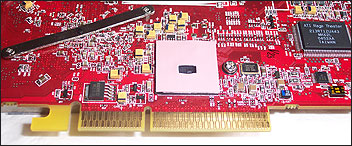To bridge, or not to bridge
That is the question. Or not, as the case turns out to be. The X800 XL is brought to AGP by the use of ATI's PCI Express-to-AGP bridge chip, codenamed RIALTO. The chip connects the native PCI Express R430 GPU that powers the SKU, to the AGP8X electrical interface of the mainboards it'll plug into. And that's basically all it has to do. While R430's external interface is PCI Express, which needs bridging, the memory unit on the GPU knows how to use AGP memory and the GPU's interface controller still knows how to talk the AGP command set.So while it's a bit more complex than just routing signals to the right pins, that's pretty much all the bridge has to do. Other hardware on the graphics board will take care of the electrical needs for signalling on the parallel bus interface and the bridge has its own clock generator for timing. While it's not a trivial process to bridge a serial bus interface to a parallel one, given the eventual similarities between AGP and PCI Express in terms of command protocols that drive the hardware and other graphics-specific issues, it's not as hard as it could be.
With the bridge in place on a board, handling the conversion, the limits of the AGP8X interface apply to the bridged product. With AGP a 32-bit bus, clocked at 66MHz, that's a 266MiB/sec bus link with 1X signal sampling. It's a bi-directional bus, so traffic can flow both ways. But since it's a half-duplex bus, that's 266MiB/sec to be shared between upstream and downstream traffic. With APG8X, where the bus signals are sampled eight times per clock with a 1.5V signalling voltage, you have just over 2GiB/sec of theoretical bus bandwidth available, bi-directionally and at half-duplex.
However, with AGP implementations, that bandwidth figure isn't available, either downstream (getting data back to the AGP host from the GPU) or upstream. Indeed, AGP8X still has a rough AGP1X transfer limit when moving data back to the AGP host and onto the CPU. So while there's 2GiB/sec to get data to the GPU, there's an eighth of that to get resulting frame data back, capping bus traffic in that direction to around 250MiB/sec.
Contrast that with PCI Express, especially in the PEG16X graphics configuration, where 16 250MiB/sec lane bundles are appropriated for bi-directional full-duplex traffic, giving you 4GiB/sec in both directions. While PEG16X rarely approaches its theoretical limits, too, it still manages to best AGP8X without difficulty.
Reality strikes with the realisation that modern 3D games aren't sending data back to the host for further processing, so write-back speeds, even if they're very low, aren't really a problem. Current measurements of bus bandwidth therefore show a difference, but that difference doesn't matter in 3D games titles.
Applications where it does matter are somewhat outside what regular consumers are using. While it makes sense that games and applications will, with the advent of PCI Express, start to use what's available in terms of new host write-back bandwidth, for the time being an AGP graphics card purchase still makes sense.
Think of RIALTO and other bridge chips not as something that holds back PCI Express graphics and stunts performance, just to get GPUs onto the AGP bus. Rather think of them as an enabler to let you get unhindered performance from your favourite graphics products on your GPU interconnect of choice.
Looking forward, RIALTO will be ATI's only method of bringing GPUs to AGP8X. R481 is ATI's latest native AGP product (as far as we're told), everything else in the future packing a PCI Express GPU and RIALTO on the same PCB.
To bridge or not to bridge is therefore an easy question to answer. For the final set of AGP SKUs that the major graphics IHVs will release, bridging is how it'll be done, and performance on a good AGP system won't be held back in the area of 3D games.
RIALTO's current packaging
On the Club3D X800 XL that's being reviewed in this article, RIALTO sits on the opposite side of the board to the GPU, on the same side that you'll find the Rage Theater AV processor that the hardware uses for VIVO capability. You can see that it doesn't need a heatsink and the chip itself is tiny. It's surrounded for its protection, to stop it being damaged accidentally. It'd be nice to see it come with a cap, although that adds to cost and complexity over a simple soft shim approach.
Its placement, near to the physical interface, means that bridged boards need a different PCB design, since RIALTO pushes the GPU away from the physical connectors due to trace routing requirements. That means boards using RIALTO, at least at the time of writing, are likely to be a little longer than you'll be used to from ATI. I'll show you what I mean in due course.
First, though, a peek at the ATI X850 XT Platinum Edition AGP reference board.










